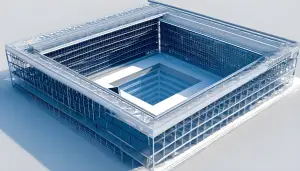Introduction:
Building Information Modeling (BIM) has transformed the architecture, engineering, and construction (AEC) industry by enabling the creation of detailed, data-rich digital representations of buildings. Beyond the design and construction phases, BIM offers significant advantages for facility management. By providing accurate and comprehensive information about a building’s structure, systems, and components, BIM can enhance the efficiency and effectiveness of facility management activities. This comprehensive guide explores how BIM can be leveraged for facility management, its benefits, challenges, and best practices.
1. Understanding BIM for Facility Management:

a. Definition:
- Building Information Modeling (BIM) for facility management involves using BIM data and technologies to manage the operational and maintenance activities of a building. It provides facility managers with detailed information about the building’s assets, systems, and spaces, enabling informed decision-making and efficient operations.
b. Key Concepts:
- Digital Twin: A digital twin is a virtual representation of a physical building, created using BIM data. It mirrors the building’s physical and functional characteristics, providing a real-time view of its performance.
- Lifecycle Management: BIM supports the entire lifecycle of a building, from design and construction to operation and maintenance. This holistic approach ensures that information is retained and accessible throughout the building’s lifespan.
2. Benefits of BIM for Facility Management:

a. Enhanced Data Accessibility:
- BIM provides a centralized repository of information, accessible to facility managers at any time. This includes detailed data on building components, systems, and spaces, which can be used for maintenance, repairs, and upgrades.
b. Improved Maintenance Planning:
- With BIM, facility managers can schedule preventive maintenance activities more effectively. Detailed information about the building’s systems and components allows for accurate tracking of maintenance needs, reducing the risk of unexpected failures.
c. Efficient Space Management:
- BIM enables better space management by providing detailed information about the building’s layout and occupancy. Facility managers can optimize space utilization, plan renovations, and ensure compliance with safety and regulatory requirements.
d. Enhanced Sustainability:
- BIM supports sustainable facility management practices by providing data on energy usage, water consumption, and other environmental metrics. Facility managers can identify opportunities for energy savings and implement green building initiatives.
e. Cost Savings:
- By improving maintenance planning, optimizing space usage, and enhancing sustainability, BIM can lead to significant cost savings. It reduces the need for emergency repairs, minimizes downtime, and extends the lifespan of building assets.
3. Key Applications of BIM in Facility Management:

a. Asset Management:
- BIM provides detailed information about building assets, including their location, condition, and maintenance history. This data can be used to manage the lifecycle of assets, plan maintenance activities, and ensure compliance with regulatory requirements.
b. Maintenance Management:
- Facility managers can use BIM to schedule and track maintenance activities. Detailed information about building systems and components allows for predictive and preventive maintenance, reducing the risk of unexpected failures and prolonging the lifespan of assets.
c. Space Management:
- BIM enables efficient space management by providing detailed information about the building’s layout and occupancy. Facility managers can optimize space utilization, plan renovations, and ensure compliance with safety and regulatory requirements.
d. Energy Management:
- BIM supports energy management by providing data on energy usage, water consumption, and other environmental metrics. Facility managers can identify opportunities for energy savings, implement green building initiatives, and track the performance of sustainability measures.
e. Emergency Management:
- In the event of an emergency, BIM can provide critical information about the building’s layout, systems, and assets. This information can be used to plan emergency response activities, ensure the safety of occupants, and minimize damage to the building.
4. Challenges in Implementing BIM for Facility Management:

a. Data Integration:
- Integrating BIM data with existing facility management systems can be challenging. Ensuring compatibility between different software platforms and data formats requires careful planning and coordination.
b. Data Accuracy:
- Maintaining accurate and up-to-date BIM data is essential for effective facility management. This requires regular updates and validation of the BIM model, as well as clear protocols for data entry and management.
c. Training and Skills:
- Facility managers need to be trained in using BIM tools and technologies. This requires investment in training programs and ongoing support to ensure that staff have the necessary skills and knowledge.
d. Cost and Resources:
- Implementing BIM for facility management can involve significant upfront costs and resource commitments. This includes investment in software, hardware, and training, as well as ongoing maintenance and support.
5. Best Practices for Implementing BIM in Facility Management:
a. Develop a Clear Strategy:
- Develop a clear strategy for implementing BIM in facility management, including goals, objectives, and key performance indicators. This will provide a roadmap for the implementation process and ensure alignment with organizational priorities.
b. Ensure Data Accuracy:
- Establish clear protocols for data entry, validation, and maintenance to ensure the accuracy and reliability of BIM data. Regularly update and validate the BIM model to reflect changes in the building’s structure and systems.
c. Invest in Training:
- Provide training and support for facility management staff to ensure they have the necessary skills and knowledge to use BIM tools and technologies effectively. This includes initial training as well as ongoing professional development.
d. Foster Collaboration:
- Foster collaboration between facility management, design, and construction teams to ensure that BIM data is shared and used effectively throughout the building’s lifecycle. This includes regular communication and coordination to address any issues or challenges.
e. Leverage Technology:
- Leverage technology to enhance the use of BIM in facility management. This includes using mobile devices, cloud computing, and IoT (Internet of Things) devices to access and manage BIM data in real-time.
6. The Future of BIM in Facility Management:

a. Emerging Technologies:
- Emerging technologies, such as artificial intelligence (AI), machine learning, and blockchain, have the potential to further enhance the use of BIM in facility management. These technologies can improve data processing, validation, and security, enabling more efficient and effective facility management practices.
b. Greater Industry Adoption:
- As the benefits of BIM for facility management become more widely recognized, industry adoption is expected to increase. This will drive further innovation and development of BIM tools and technologies, making them more accessible and affordable for facility managers.
c. Integration with Smart Building Systems:
- The integration of BIM with smart building systems, such as IoT devices and building automation systems, will enable more efficient and effective facility management. This includes real-time monitoring and control of building systems, predictive maintenance, and enhanced energy management.
Conclusion:
BIM offers significant advantages for facility management by providing accurate and comprehensive information about a building’s structure, systems, and components. By leveraging BIM, facility managers can enhance data accessibility, improve maintenance planning, optimize space usage, and promote sustainability. However, implementing BIM for facility management also presents challenges, including data integration, accuracy, and the need for training and resources. By following best practices and staying abreast of emerging technologies, facility managers can unlock the full potential of BIM and achieve more efficient and effective facility management.
Frequently Asked Questions (FAQs) – BIM for Facility Management:
1. What is BIM for facility management?
- BIM for facility management involves using BIM data and technologies to manage the operational and maintenance activities of a building. It provides facility managers with detailed information about the building’s assets, systems, and spaces.
2. What are the benefits of using BIM for facility management?
- Benefits of using BIM for facility management include enhanced data accessibility, improved maintenance planning, efficient space management, enhanced sustainability, and cost savings.
3. What are some key applications of BIM in facility management?
- Key applications of BIM in facility management include asset management, maintenance management, space management, energy management, and emergency management.
4. What are the challenges in implementing BIM for facility management?
- Challenges in implementing BIM for facility management include data integration, data accuracy, training and skills, and cost and resource commitments.
5. How can facility managers ensure successful implementation of BIM?
- Facility managers can ensure successful implementation of BIM by developing a clear strategy, ensuring data accuracy, investing in training, fostering collaboration, and leveraging technology.
6. What is the future of BIM in facility management?
- The future of BIM in facility management includes the adoption of emerging technologies, greater industry adoption, and integration with smart building systems to enhance efficiency and effectiveness.






